Physical Address
304 North Cardinal St.
Dorchester Center, MA 02124
The ophthalmologist needs to make an exact ocular and systemic diagnosis in patients with eyes that are smaller than normal or those with malformations affecting anterior or posterior structures. A precise diagnosis allows good counseling of patients and families, an educated guess at visual outcomes and screening for possible ocular or systemic complications. Conditions that are associated with a small ocular size include microphthalmia, anophthalmia, nanophthalmos, posterior microphthalmia, persistence of the fetal vasculature, also known as persistent hyperplastic primary vitreous, and some cases of aniridia or Peters anomaly.
Eye development begins during the gastrula stage. At this stage, the embryo consists of a primitive ectoderm known as the epiblast. Inductively active mesodermal cells of the midline (prechordal plate, notochord) are necessary to divide the eye field along the midline to generate two separate eye fields. A key inductive signal in this process is the Sonic hedgehog gene ( SHH ). Failure of midline formation results in cyclopia, or fusion of the eyes (see below).
The vertebrate eye is a composite organ that forms from the joining of a number of structures derived from different embryological layers ( Fig. 16.1 ). A number of genes are involved in this most orderly process of eye formation, some of which are shown in Fig. 16.1 . In brief, the optic vesicle derives from the developing neuroectoderm of the forebrain, while the lens placode originates from the surface ectoderm. The portion of the optic vesicle that comes into contact with the lens placode invaginates so that the resulting inner layers form the retina while the outer layer forms the retinal pigment epithelium. At this optic cup stage, the eye has formed its basic pattern. The vitreous cavity forms between the lens and the retina, while the ciliary body and the iris arise from the margins of the optic cup. The optic cup has an inferior fissure that closes as development proceeds. Failure of this fetal fissure to close leads to the formation of typical colobomas. The term typical refers to their inferior location, not to their appearance or extent. Neural crest cells migrate into the space between the lens and corneal ectoderm to build the stromal and endodermal layers of the cornea. Neural crest mesenchyme also migrates into close contact with the pigment epithelium to form the sclera and muscles of the eye. Interference with the establishment of these primordia and their inductive interactions are possible causes of anophthalmia, colobomas, and microphthalmia.
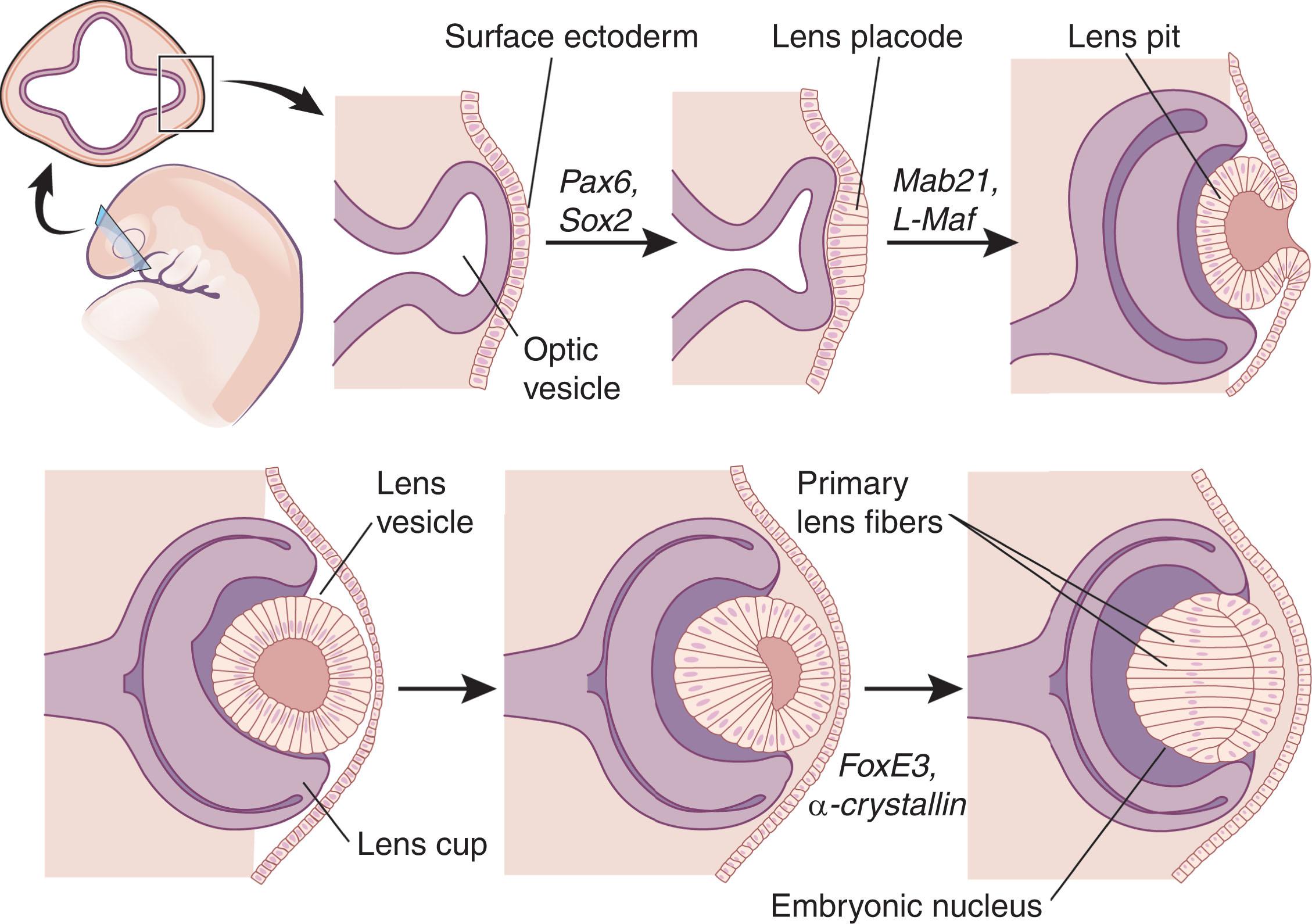
The spectrum of microphthalmia, anophthalmia, and coloboma (MAC) refers to related structural, congenital eye malformations that display a range of severity and which can occur in isolation or as part of a syndrome.
The birth prevalence of anophthalmia ranges from 0.6 to 4.2 per 100,000 births, while microphthalmia occurs in 2–17 per 100,000 births, and coloboma (predominantly of the iris) in 2–14 per 100,000 births. A study that analyzed data from live births in Texas between 1999 and 2009 found the combined overall prevalence of anophthalmia and microphthalmia to be 3 per 10,000 births, with approximately half of the 1262 patients presenting with an associated syndrome. However, the incidence rate of MAC is higher in highly consanguineous communities. There is some evidence to suggest a higher incidence in the more socioeconomically deprived. While cluster studies have failed to identify causal links between environmental factors and microphthalmia/anophthalmia, prenatal infections with rubella, toxoplasmosis, varicella, cytomegalovirus, parvovirus B19, influenza, and coxsackie A9 have been implicated. Maternal vitamin A deficiency, hyperthermia, X-ray exposure, solvent misuse, and prenatal drug exposure (thalidomide, warfarin, alcohol) have been postulated as potential non-infectious etiologies.
The term “anophthalmia” is applied when the eye appears to be non-existent ( Fig. 16.2 ) and is not visible. The term “clinical anophthalmia” emphasizes that there is a spectrum in which true anophthalmia merges with extreme microphthalmia in which only a small remnant of the eye is identified on pathology. True anophthalmia is sometimes associated with absence of the optic nerve and chiasm, as in some patients with SRY-Box2 ( SOX2 ) mutations.
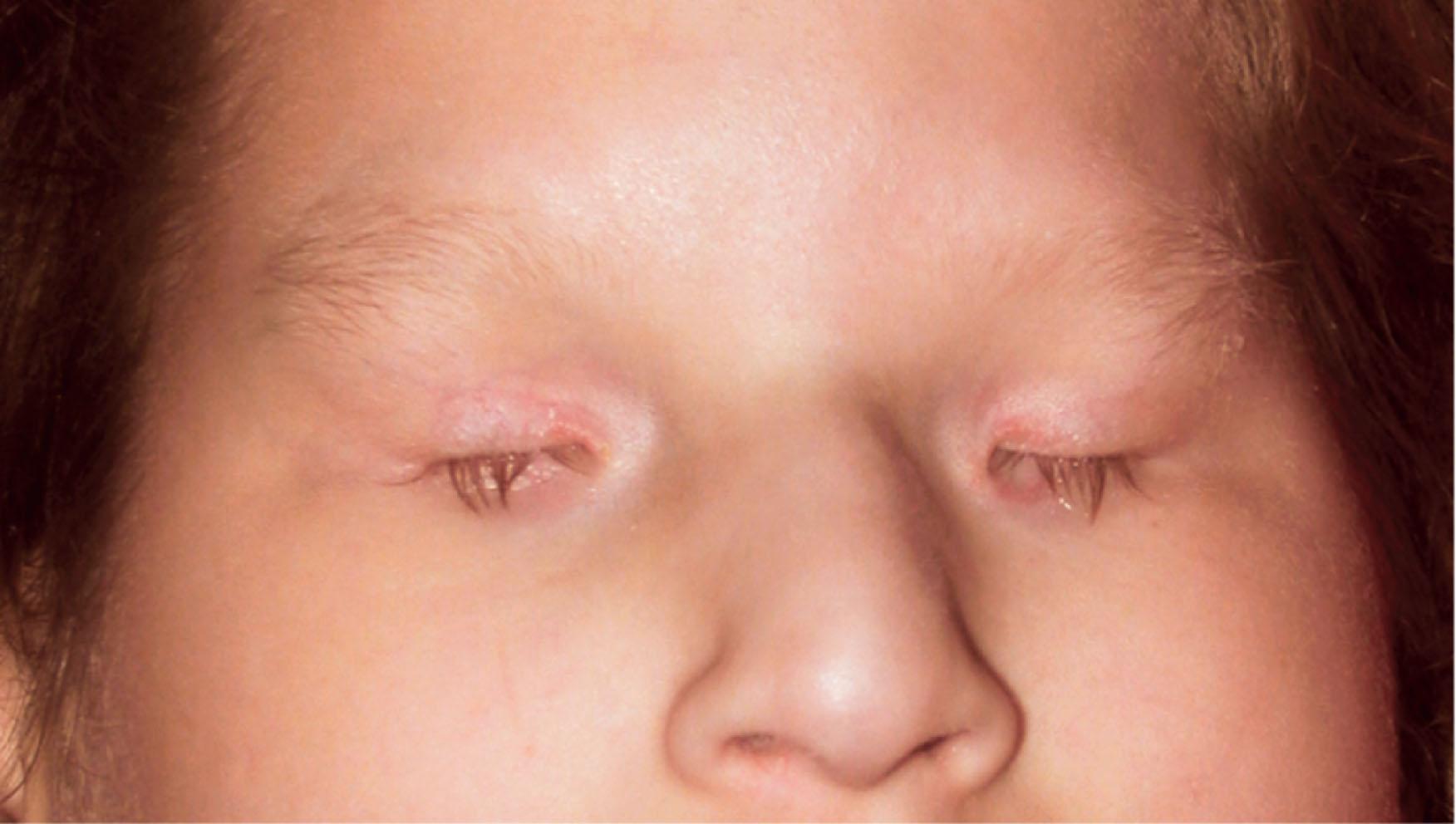
There are three types of anophthalmia. The primary type results from a failure of development of the optic pit(s) to form the optic vesicle, while the secondary type results from a failure of development of the anterior neural tube. A third category, consecutive or degenerative anophthalmia, refers to cases where optic vesicles have degenerated and disappeared subsequent to formation.
Secondary abnormalities of the orbit occur in patients in whom the eye is very small or absent; in such cases orbital growth is always retarded. Extraocular muscles may be absent, and the optic foramen is often reduced in size. The conjunctival sac may be small and shallow. Although the absence of a developing eye does not affect the initial development of a bony orbit, the growth of the orbit is highly influenced by the presence or absence of the globe and its size. The mean axial length of the human full-term neonatal and adult eye is approximately 17.0 and 23.8 mm, respectively, with the normal neonatal eye measuring 70% of the adult size. Orbital volume increases dramatically during the first 3 years of life, especially in the first year.
While orbital volume cannot be assessed using plain radiographs, the horizontal and vertical sizes of the orbital openings from the orbital rim can be measured and are reduced in adults with congenital anophthalmia and in those enucleated within the first year of life. This retardation of orbital growth is halved when an orbital implant is used, and the severity of the overall reduction in volume diminishes if the insult occurs at a later date. Orbital growth appears to be complete by the age of 15 years, but a decrease in orbital size can continue after subsequent enucleation.
It is beyond the scope of this chapter to discuss in depth the management of the anophthalmic socket, but treatment should begin as soon as possible in patients with anophthalmia who have severe constriction of the conjunctival cul-de-sac and orbit, as late intervention can lead to an underdeveloped socket with impaired ability to wear a prosthesis later in life. Socket expansion with self-inflating expanders or custom-made conformers likely produce similar or better results than static implants. Dermis-fat grafts act as dynamic orbital implants, and they could be used after adequate lid and socket expansion with custom-made conformers.
Many causes for anophthalmia have been proposed, and some are the same as those of microphthalmia (see below). Bilaterality and increased severity of microphthalmia/anophthalmia imply an early teratogenic or genetic developmental event. In isolated cases of genetic etiology, inheritance may be autosomal dominant or autosomal recessive. In some families with clear Mendelian inheritance, ocular pathology may be asymmetric or even unilateral. Mutations in SOX2 are one of the more common causes of anophthalmia. Several other genes have been implicated in anophthalmia as well ( Table 16.1 ).
| Gene symbol | OMIM ID | Gene | Locus | Inheritance | Manifestations |
|---|---|---|---|---|---|
| ABCB6 | 605452 | ATP-Binding Cassette, Subfamily B, Member 6 | 2q35 | AD | Isolated colobomatous microphthalmia |
| ACTB | 102630 | Actin, Beta | 7p22.1 | AD | Coloboma, facial abnormalities, sensorineural deafness, shoulder girdle muscle bulk, progressive joint stiffness, pachygyria with anteroposterior severity gradient, cleft lip and palate, hallux duplex, congenital heart defects, renal tract anomalies (Baraitser–Winter syndrome 1) |
| ACTG1 | 102560 | Actin, Gamma-1 | 17q25.3 | AD | Coloboma, microcephaly, short stature, intellectual disability, hearing loss, seizures, facial abnormalities, lissencephaly (Baraitser-Winter syndrome 2) |
| ALDH1A3 | 600463 | Aldehyde Dehydrogenase 1 Family, A3 | 15q26.3 | AR | Isolated colobomatous microphthalmia, anophthalmia |
| ALX1 | 601527 | Aristaless-Like Homeobox 1 | 12q21.31 | AR | Frontonasal dysplasia (bilateral extreme microphthalmia, bilateral oblique facial cleft, complete cleft palate, hypertelorism, wide nasal bridge with hypoplasia of the ala nasi, low-set posteriorly rotated ears) |
| ATOH7 | 609875 | Atonal Homolog 7 | 10q21.3 | AR | Non-colobomatous microphthalmia, vitreoretinal dysplasia, optic nerve hypoplasia, persistent fetal vasculature, congenital cataract, microcornea, corneal opacity, nystagmus |
| BCOR | 300485 | BCL6 Corepressor | Xp11.4 | XLD | Colobomatous microphthalmia, cataracts, glaucoma, retinal detachment, cardiac defects, skeletal defects, dental anomalies, facial anomalies (oculofaciocardiodental syndrome) |
| BMP4 | 112262 | Bone Morphogenetic Protein 4 | 14q22–23 | AD | Colobomatous microphthalmia, clinical anophthalmia, brain and digit developmental anomalies, micrognathia, abnormal external genitalia |
| BMP7 | 112267 | Bone Morphogenetic Protein 7 | 20q13.31 | Sporadic; complex inheritance | Colobomatous microphthalmia, anophthalmia, sensorineural hearing loss, cleft palate, tracheoesophageal fistula, hemivertebrae, developmental delays, seizures, growth retardation |
| C12ORF57 | 615140 | Chromosome 12 Open Reading Frame 57 | 12q13.31 | AR | Colobomatous microphthalmia, global developmental delay, seizures, corpus callosum abnormalities (Temtamy syndrome) |
| CHD7 | 608892 | Chromodomain Helicase DNA-Binding Protein 7 | 8q12.1–q12.2 | AD | Colobomatous microphthalmia, heart defects, choanal atresia, growth retardation, genital abnormalities, ear abnormalities (CHARGE syndrome) |
| CNKSR1 | 603272 | Connector Enhancer Of Kinase Suppressor Of Ras 1 | 1p36.11 | Unknown | Colobomatous microphthalmia, microcornea, intellectual disability |
| COL4A1 | 120130 | Collagen,Type IV, Alpha-1 | 13q34 | AD | Non-colobomatous microphthalmia, cerebrovascular disease with variable ocular anomalies, kidney and muscle defects |
| CRYAA | 123580 | Crystallin Alpha A | 21q22.3 | AD | Colobomatous microphthalmia, cataract, microcornea |
| DSC3 | 600271 | Desmocollin 3 | 18q12.1 | AR | Colobomatous microphthalmia, hypoplastic columella, flat nasal bridge, micropenis |
| FAT1 | 600976 | Fat Atypical Cadherin 1 | 4q35.2 | AR | Colobomatous microphthalmia, ptosis, nephropathy, syndactyly |
| FNBP4 | 615265 | Formin-Binding Protein 4 | 11p11.2 | Colobomatous microphthalmia, anophthalmia, distal limb anomalies (Waardenburg anophthalmia syndrome) | |
| FOXE3 | 601094 | Forkhead Box E3 | 1p32 | AR | Colobomatous microphthalmia, optic disc coloboma, sclerocornea, aphakia |
| FRAS1 | 607830 | Fraser Extracellular Matrix Complex, Subunit 1 | 4q21.21 | AR | Manitoba oculotrichoanal (MOTA) syndrome with microphthalmia, anophthalmia, cryptophthalmos, eyelid colobomas, aberrant hairline, bifid or broad nasal tip, GI anomalies, labial fusion |
| FREM1 | 608944 | Fras1-related Extracellular Matrix Protein 1 | 9p22.3 | AR | Manitoba oculotrichoanal (MOTA) syndrome with microphthalmia, anophthalmia, cryptophthalmos, eyelid colobomas, aberrant hairline, bifid or broad nasal tip, GI anomalies |
| FZD5 | 601723 | Frizzled Class Receptor 5 | 2q33.3 | AD | Isolated or syndromic coloboma with cataract, deafness, neurocognitive difficulties |
| GDF3 | 606522 | Growth Differentiation Factor 3 | 12p13.1 | AD | Isolated or syndromic colobomatous microphthalmia, anophthalmia, skeletal anomalies |
| GDF6 | 601147 | Growth Differentiation Factor 6 | 8q22.1 | AD | Isolated colobomatous microphthalmia, anophthalmia, nanophthalmos |
| GJA1 | 121014 | Gap Junction Protein, Alpha-1 | 6q22.31 | AD/AR | Non-colobomatous microphthalmia, microcornea, syndactyly, facial dysmorphia (oculodentodigital syndrome) |
| GJA8 | 600897 | Gap Junction Protein Alpha-8 | 1q21.2 | AD | Colobomatous microphthalmia, cataract, aphakia, sclerocornea |
| HCCS | 300056 | Holocytochrome C Synthase | Xp22.2 | XLD | Non-colobomatous microphthalmia with linear skin defects |
| HMGB3 | 300193 | High Mobility Group 3 | Xq28 | XL | Colobomatous microphthalmia, microcephaly, short stature, psychomotor retardation |
| HMX1 | 142992 | H6 Family Homeobox 1 | 4p16.1 | AR | Colobomatous microphthalmia, cataract, anterior segment dysgenesis, early-onset retinal dystrophy, abnormal external ear cartilage (oculoauricular syndrome) |
| IPO13 | 610411 | Importin 13 | Qp34.1 | AR | Colobomatous microphthalmia, cataract |
| KMT2D | 602113 | Lysine-Specific Methyltransferase 2D | 12q13.12 | AD | Colobomatous microphthalmia, cleft palate, congenital diaphragmatic hernia, duplex kidney, facial dysmorphia (Kabuki syndrome) |
| LAMB2 | 150325 | Laminin, Subunit Beta 2 | 3p21.31 | AR | Non-colobomatous microphthalmia, nystagmus, myopia, strabismus, renal failure (nephrotic syndrome, type 5, with or without ocular abnormalities) |
| LRP2 | 600073 | Low Density Lipoprotein Receptor-Related Protein 2 | 2q31.1 | AR | Coloboma, diaphragmatic hernia, exomphalos, absent corpus callosum, hypertelorism, myopia, sensorineural deafness, proteinuria (Donnai–Barrow syndrome) |
| MAB21L2 | 604357 | Mab21-Like 2 | 4q 31.1 | AD/AR | Colobomatous microphthalmia, clinical anophthalmia, rhizomelic skeletal dysplasia |
| MAF | 177075 | MAF bZIP Transcription Factor | 16q23.2 | AD | Colobomatous microphthalmia, glaucoma, microcornea, Peters anomaly, cataract |
| MITF | 156845 | Microphthalmia-Associated Transcription Factor | 3p13 | AR | Coloboma, osteopetrosis, microphthalmia, macrocephaly, albinism, deafness (COMMAD) |
| NAA10 | 300013 | N-Alpha-Acetyltransferase 10 | Xq28 | XL | Colobomatous microphthalmia, anophthalmia, impaired intellectual development, large and dysplastic ears with skin tags, high-arched or cleft palate, dental anomalies, urogenital anomalies, skeletal manifestations (Lenz microphthalmia) |
| NDUFB11 | 300403 | NADH-Ubiquinone Oxidoreductase 1 Beta Subcomplex, 11 | Xp11.3 | XLD | Colobomatous microphthalmia, sclerocornea, dermal aplasia, neurologic and cardiac abnormalities (microphthalmia with linear skin defects syndrome) |
| OLFM2 | 617492 | Olfactomedin-2 | 19p13.2 | Colobomatous microphthalmia, short stature, facial dysmorphism | |
| OTX2 | 600037 | Orthodenticle, Drosophila, Homolog of, 2 | 14q22–23 | Sporadic; complex inheritance | Colobomatous microphthalmia, clinical anophthalmia, microcornea, cataract, retinal dystrophy, hypoplasia/agenesis of the optic nerve, agenesis of the corpus callosum, developmental delay, joint laxity, hypotonia, seizures |
| PAX2 | 167409 | Paired Box Gene 2 | 10q24.31 | AD | Optic nerve coloboma, microphthalmia, renal disease (papillorenal syndrome) |
| PAX6 | 607108 | Paired Box Gene 6 | 11p13 | AD | Colobomatous microphthalmia, clinical anophthalmia, aniridia |
| PITX3 | 602669 | Paired-Like Homeodomain Transcription Factor 3 | 4q25 | AD/AR | Non-colobomatous microphthalmia, posterior polar cataract, neurodevelopmental abnormalities |
| POMT1 | 607423 | Protein O-Mannosyltransferase 1 | 9q34.13 | AR | Colobomatous microphthalmia, cobblestone lissencephaly, cerebellar malformations, retinal malformations (congenital muscular dystrophy-dystroglycanopathy with brain and eye anomalies) |
| PORCN | 300651 | Porcupine O-Acyltransferase | Xp11.23 | XLD | Colobomatous microphthalmia, focal dermal hypoplasia, digital anomalies, oral anomalies (focal dermal hypoplasia) |
| PRSS56 | 613858 | Protease, Serine, 56 | 2q37.1 | AR | Non-colobomatous posterior microphthalmia, nanophthalmos |
| PTCH1 | 601309 | Patched, Drosophila, Homolog of, 1 | 9q22.32 | AD | Colobomatous microphthalmia, anophthalmia, cataracts, sclerocornea, Peters anomaly, anterior segment dysgenesis, corpus callosum abnormalities, cardiac abnormalities |
| PXDN | 605158 | Peroxidasin | 2p25.3 | AR | Non-colobomatous microphthalmia, anterior segment dysgenesis |
| RAB18 | 602207 | Ras-Associated Protein RAB18 | 10p12.1 | AR | Non-colobomatous microphthalmia, microcephaly, microcornea, cataract, optic atrophy, cortical dysplasia, mental retardation, spastic diplegia, hypogonadism (Warburg micro syndrome 3) |
| RAB3GAP1 | 602536 | Rab3 GTPase-Activating Protein, Catalytic Subunit | 2q21.3 | AR | Non-colobomatous microphthalmia, microcephaly, microcornea, cataract, optic atrophy, cortical dysplasia, mental retardation, spastic diplegia, hypogonadism (Warburg micro syndrome 1) |
| RAB3GAP2 | 609275 | Rab3 GTPase-Activating Protein, Noncatalytic Subunit | 1q41 | AR | Non-colobomatous microphthalmia, microcephaly, microcornea, cataract, optic atrophy, cortical dysplasia, mental retardation, spastic diplegia, hypogonadism (Warburg micro syndrome 2) |
| RARB | 180220 | Retinoic Acid Receptor Beta | 3p24.2 | AR/AD | Colobomatous microphthalmia, anophthalmia, pulmonary hypoplasia, diaphragmatic hernia, cardiac defects (PDAC) |
| RAX | 601881 | Retina And Anterior Neural Fold Homeobox | 18q21.32 | AR | Isolated colobomatous microphthalmia, clinical anophthalmia |
| RBP4 | 180250 | Retinol-Binding Protein 4 | 10q23.33 | AD | Isolated colobomatous microphthalmia, clinical anophthalmia |
| SALL2 | 602219 | Sal-Like 2 | 14q11.2 | AR | Isolated coloboma |
| SALL4 | 607343 | Sal-Like 4 | 20q13.2 | AD | Colobomatous microphthalmia, optic nerve hypoplasia, cardiac defects, growth delay, acro-reno-ocular syndrome (Duane-radial ray syndrome) |
| SCLT1 | 611399 | Sodium Channel And Clathrin Linker 1 | 4q28.2 | Unknown | Colobomatous microphthalmia, anophthalmia, midline cleft lip and palate, microcephaly, choanal atresia, heart defects, micropenis (oro-facio-digital syndrome type IX) |
| SEMA3E | 608166 | Semaphorin 3E | 7q21.11 | AD | Colobomatous microphthalmia, heart defects, choanal atresia, growth retardation, genital abnormalities, ear abnormalities (CHARGE syndrome) |
| SHH | 600725 | Sonic Hedgehog | 7q36.3 | AD | Isolated colobomatous microphthalmia |
| SIX6 | 606326 | Sine Oculus Homeobox | 14q23.1 | AR | Non-colobomatous microphthalmia, anterior segment dysgenesis, posterior segment dysgenesis |
| SLC18A2 | 193001 | Solute Carrier Family 18, Member 2 | 10q25.3 | AR | Non-colobomatous microphthalmia, global developmental delay, dystonia, microcephaly, seizures, hypotonia, Parkinsonism |
| SLC25A24 | 608744 | Solute Carrier Family 25, Member 24 | 1p13.3 | AD | Non-colobomatous microphthalmia, short downslanting palpebral fissures, craniosynostosis, brachycephaly, severe midface hypoplasia, hypertrichosis, conductive hearing loss, high-arched narrow palate, dental anomalies, short stature, brachydactyly, genital hypoplasia (Gorlin–Chaudry–Moss syndrome) |
| SMCHD1 | 614982 | Structural Maintenance Of Chromosomes Flexible Hinge Domain Containing Protein 1 | 18p11.32 | AD | Colobomatous microphthalmia, arhinia with hypoplasia of maxilla and midface, hypogonadotropic hypogonadism, cryptorchidism, microphallus (Bosma arhinia microphthalmia syndrome) |
| SMO | 601500 | Smoothened, Frizzled Class Receptor | 7q32.1 | Somatic mosaicism | Colobomatous microphthalmia, patchy skin lesions, diverse cerebral malformations, unicoronal craniosynostosis, intestinal malrotation (Curry–Jones syndrome) |
| SMOC1 | 608488 | SPARC-Related Modular Calcium-Binding 1 | 14q24.2 | AR | Colobomatous microphthalmia, anophthalmia, distal limb anomalies (Waardenburg anophthalmia syndrome) |
| SOX2 | 184429 | SRY-Box 2 | 3q26.3–27 | AD | Colobomatous microphthalmia, clinical anophthalmia, brain anomalies, seizures, motor disability, neurocognitive delays, sensorineural hearing loss, esophageal atresia, hypoplasia of anterior pituitary |
| SOX3 | 313430 | SRY-Related HMG-Box Gene 3 | Xq27.1 | XL | Colobomatous microphthalmia, intellectual disability, hypopituitarism, facial dysmorphism, dental anomalies |
| STRA6 | 610745 | Stimulated By Retinoic Acid 6 | 15q24.1 | AR | Isolated or syndromic colobomatous microphthalmia, clinical anophthalmia, pulmonary hypoplasia/aplasia, cardiac malformations, diaphragmatic defects (PDAC) |
| TBC1D20 | 611663 | TBC1 Domain Family, Member 20 | 20p13 | AR | Non-colobomatous microphthalmia, microcephaly, microcornea, cataract, optic atrophy, cortical dysplasia, mental retardation, spastic diplegia, hypogonadism (Warburg micro syndrome 4) |
| TBC1D32 | 615867 | TBC1 Domain Family, Member 32 | 6q22.31 | AR | Colobomatous microphthalmia, anophthalmia, microcephaly, midline cleft, cardiac anomalies, choanal stenosis, polydactyly, panhypopituitarism, seizures (oro-facio-digital syndrome type IX) |
| TENM3 | 610083 | Teneurin Transmembrane Protein 3 | 4q34.3–q35.1 | AR | Isolated colobomatous microphthalmia; colobomatous microphthalmia, developmental delay, ptosis, microcornea, sclerocornea, anterior segment dysgenesis |
| TFAP2A | 107580 | Transcription Factor AP2-Alpha | 6p24.3 | AD | Colobomatous microphthalmia, branchial cleft sinus defects, facial dysmorphia (branchiooculofacial syndrome) |
| TMX3 | 616102 | Thioredoxin-Related Transmembrane Protein 3 | 18q22.1 | Isolated colobomatous microphthalmia | |
| VAX1 | 604294 | Ventral Anterior Homeobox 1 | 10q25.3 | AR | Colobomatous microphthalmia, cleft lip and palate, agenesis of the corpus callosum |
| VSX2 | 142993 | Visual System Homeobox 2 | 14q24.3 | AR | Colobomatous microphthalmia, cataracts, iris abnormalities |
| YAP1 | 606608 | YES1-Associated Transcriptional Regulator | 11q22.1–q22.2 | AD | Colobomatous microphthalmia with or without hearing impairment, cleft lip/palate, mental retardation |
| ZEB2 | 605802 | Zinc Finger E Box-Binding Homeobox 2 | 2p22.3 | AD | Colobomatous microphthalmia, distinct facial phenotype, intellectual deficiency, epilepsy, Hirschsprung disease, genitourinary anomalies, congenital heart defects, agenesis of corpus callosum (Mowat–Wilson syndrome) |
| ZNF219 | 605036 | Zinc Finger Protein 219 | 14q11.2 | Unknown | Isolated colobomatous microphthalmia |
Microphthalmia refers to an ocular globe that is 2 or more standard deviations below expected size for chronological age. Microphthalmia may be simple (small but otherwise structurally normal) or complex (associated with anterior segment malformations, cataracts, colobomas, or other retinal or vitreous disease). It can be also be classified as colobomatous ( Fig. 16.3 ) or non-colobomatous ( Fig. 16.4 ) on the basis of associated uveal defects. Microphthalmia is a common feature of a variety of genetic syndromes with systemic manifestations (see Table 16.1 ). It is important for the clinician to distinguish between the various presentations of microphthalmia (simple vs. complex, colobomatous vs. non-colobomatous, and isolated vs. syndromic), as making the proper diagnosis will direct appropriate counseling and medical management of patients and their families.
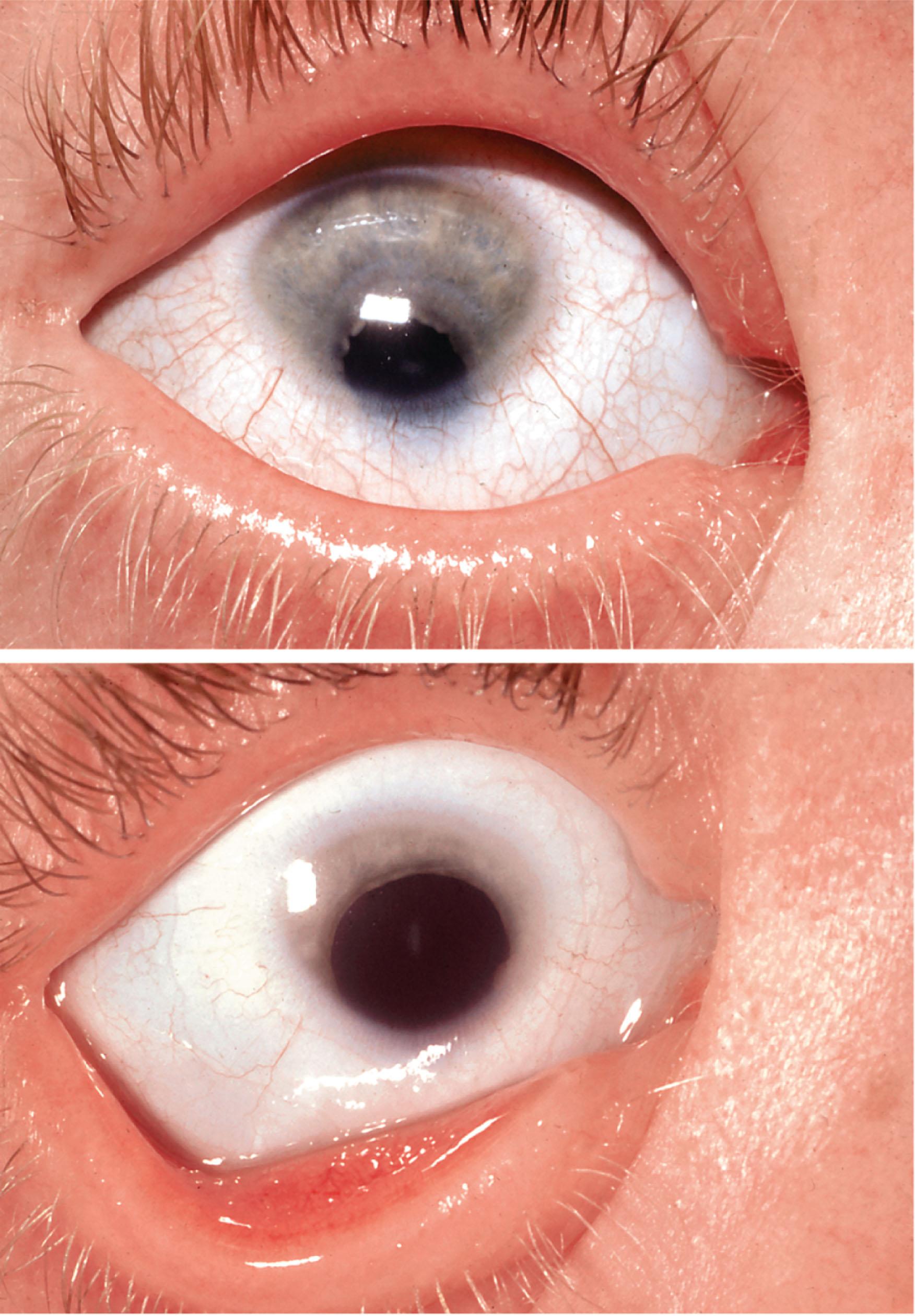
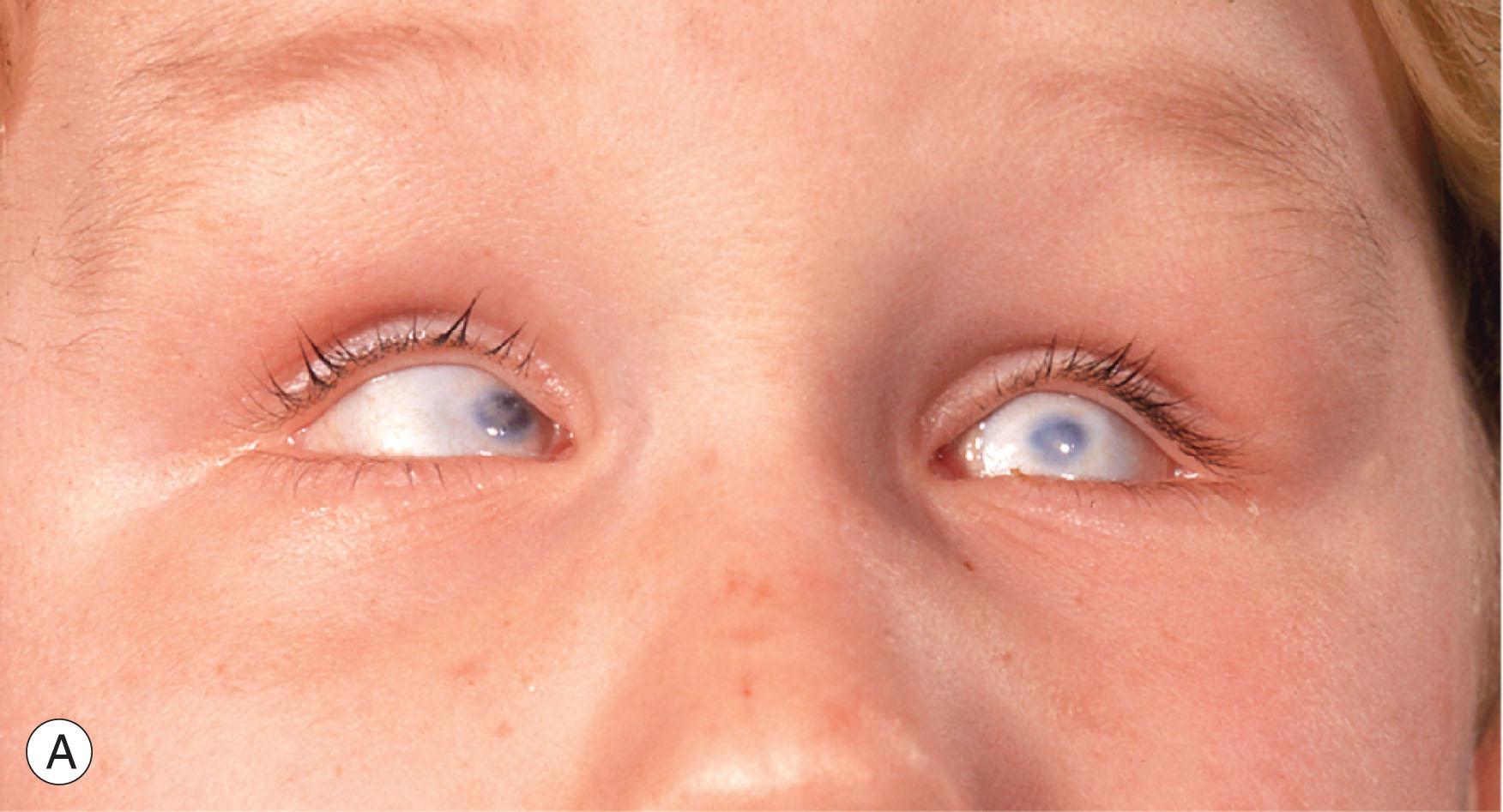
Etiologically, microphthalmia represents a non-specific growth failure of the eye in response to prenatal insults and/or genetic defects. Inadequate postnatal growth, secondary to decreased size of the optic cup, altered vitreous composition, and low intraocular pressure, may play a role in the pathogenesis of simple microphthalmos. Posterior segment abnormalities and complex microphthalmia may be secondary to inadequate production of secondary vitreous. The volume of the microphthalmic eye is reduced and, often, clinical suspicion of microphthalmia arises from a corneal diameter less than 9 or 10 mm. Although microphthalmia is usually associated with a small cornea, there are patients with microphthalmia and a normal corneal diameter, and others with microcornea without microphthalmia. Ultrasonographic determination of an axial length less than 21 mm in an adult or 14 mm in a newborn supports a diagnosis of microphthalmia.
Microphthalmia is reported in approximately 3%–11% of blind children, and studies have shown that 81% of microphthalmic eyes and 93% of microphthalmic eyes with coloboma have reduced vision. The effect of microphthalmia on vision depends on whether it is bilateral, the severity of the microphthalmia, and the presence of concurrent ocular malformations – specifically, the degree of retinal and foveal maldevelopment, involvement of the macula and optic nerve head, and the presence or absence of cataract and coloboma.
Simple microphthalmia refers to an otherwise structurally normal but small eye and has been used interchangeably with “nanophthalmos” (though the latter refers to a small eye with microcornea, axial length <18 mm, and ≥ 8D of hypermetropia, see below). Vision is variably affected, depending on the degree to which the eye is microphthalmic, associated high errors of refraction and consequent amblyopia, and complications in some cases of nanophthalmos such as a macular fold and uveal effusion or glaucoma. As microphthalmia and coloboma are regarded as eye abnormalities on a spectrum with possible shared pathophysiology, the distinction between the two is somewhat arbitrary and rarely are genes associated solely with simple non-colobomatous microphthalmia (see Table 16.1 ).
Coloboma is the most common ocular malformation associated with microphthalmia and is found in syndromic and isolated forms of microphthalmia. Failure of the optic fissure to close during the 5th week of gestation results in uveal coloboma, affecting any combination of iris, choroid, retina, and optic nerve. A number of genes have been associated with recessively or dominantly inherited isolated colobomatous microphthalmia, including ABCB6 , ALDH1A3 , GDF6 , and SHH , and several more genes are associated with syndromic colobomatous microphthalmia (see Table 16.1 ). Some families demonstrate dominant inheritance of colobomatous microphthalmia and variable expression, with extreme microphthalmia at one end of the spectrum and small iris or fundus colobomas at the other. X-linked inheritance is documented with syndromic colobomatous microphthalmia, sometimes presenting with mental retardation, as in the case of BCOR or SOX3 mutation.
While coloboma frequently co-occurs with microphthalmia, it is commonly seen without microphthalmia and has an estimated prevalence of 1 per 5000 live births. COACH syndrome, characterized by cerebellar vermis hypoplasia, oligophrenia, ataxia, coloboma, and hepatic fibrosis, is one example of syndromic coloboma without microphthalmia or anophthalmia, and has been attributed to mutations in TMEM67 .
A large number of syndromes have been associated with MAC (see Table 16.1 ); 33%–95% of patients with anophthalmia and microphthalmia have associated systemic abnormalities, and microphthalmia can present with a variety of associated ocular anomalies, including anterior segment malformations such as Axenfeld Rieger syndrome or cataracts, especially in the context of chromosomal abnormalities, persistent fetal vasculature (PFV), aphakia, and multisystem syndromes such as the oculo-dento-digital syndrome. A small eye may be the result of severe, widespread intraocular disease including advanced retinopathy of prematurity, retinal dysplasia, and retinal folds.
Many patients with microphthalmia-associated syndromes, especially chromosomal disorders, are developmentally delayed or have cleft palate. We will only mention a few of these syndromes in this section, an extensive list with highlights of each condition is given in Table 16.1 .
One of the most common syndromic causes of colobomatous microphthalmia is the CHARGE syndrome (coloboma, heart abnormalities, atresia of the choanae, retardation of growth and development, genitourinary abnormalities, and ear/hearing abnormalities). Affected patients can also have cranial nerve abnormalities such as facial nerve palsy, craniofacial clefting, dysphagia/esophageal abnormalities, duplication of the thumb, and congenital brain abnormalities, particularly of the forebrain. Although most cases are sporadic, autosomal dominant transmission has been reported. Mutations in the Chromodomain Helicase DNA-Binding Protein 7 gene ( CHD7 ) are responsible for 60% of CHARGE cases, with unlikely genotype–phenotype correlation. CHD7 encodes a putative chromodomain protein widely expressed in the neuroectoderm and in neural crest cells during human development. Mutations in the Semaphorin 3E gene ( SEMA3E ) can also result in CHARGE syndrome.
The Temple–al-Gazali syndrome ( Fig. 16.5 ), also referred to as X-linked dominant microphthalmia with linear skin defects (MLS) syndrome, and also known as the microphthalmia, dermal aplasia, and sclerocornea (MIDAS) syndrome, results from mutation of the Holocytochrome C Synthase gene ( HCCS ) and maps to Xp22.2. Mutations in NADH-Ubiquinone Oxidoreductase 1 Beta Subcomplex 11 ( NDUFB11 ) gene have also been implicated. Patients have linear, irregular areas of skin aplasia, especially of the head and neck, microphthalmia with variable sclerocornea, and, sometimes, abnormal intelligence. The condition is lethal in XY males.
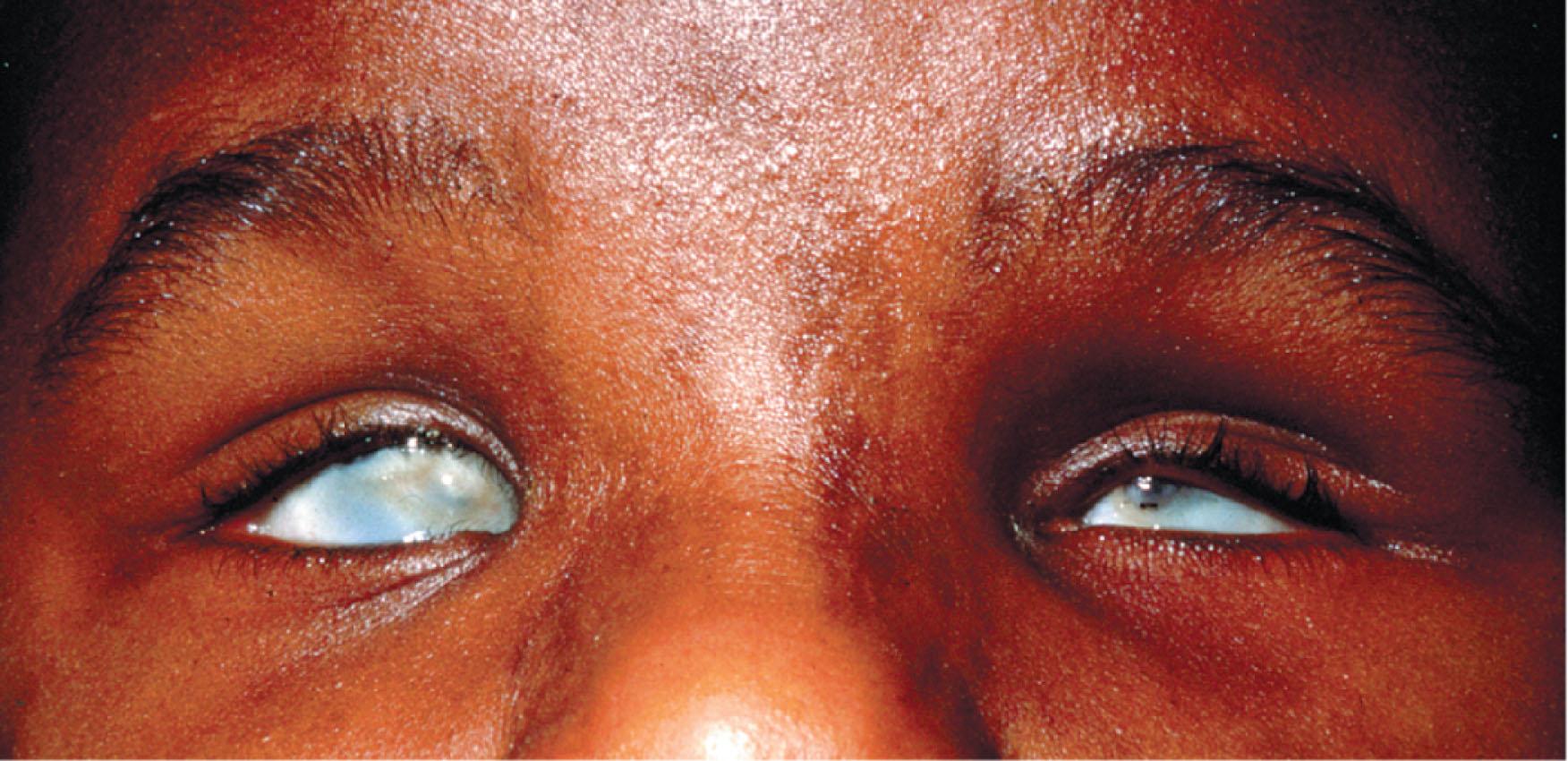
In Fryns “anophthalmia plus” syndrome , there is microphthalmia or anophthalmia, cleft lip or palate, and sacral neural tube defect.
The branchio-oculo-facial syndrome presents with ocular manifestations of colobomatous microphthalmia, nasolacrimal duct obstructions, orbital cysts as well as branchial cleft sinus defects and craniofacial abnormalities, and it has been attributed to mutations in Transcription Factor AP2-Alpha ( TFAP2A ). Other microphthalmia syndromes with facial defects include fronto-facio-nasal dysplasia ( Fig. 16.6 ), frontonasal dysplasia associated with mutations in Aristaless-Like Homeobox 1 ( ALX1 ), and the cerebro-oculo-nasal syndrome in which there is an association of anophthalmia/microphthalmia, abnormal nares, and central nervous system anomalies.
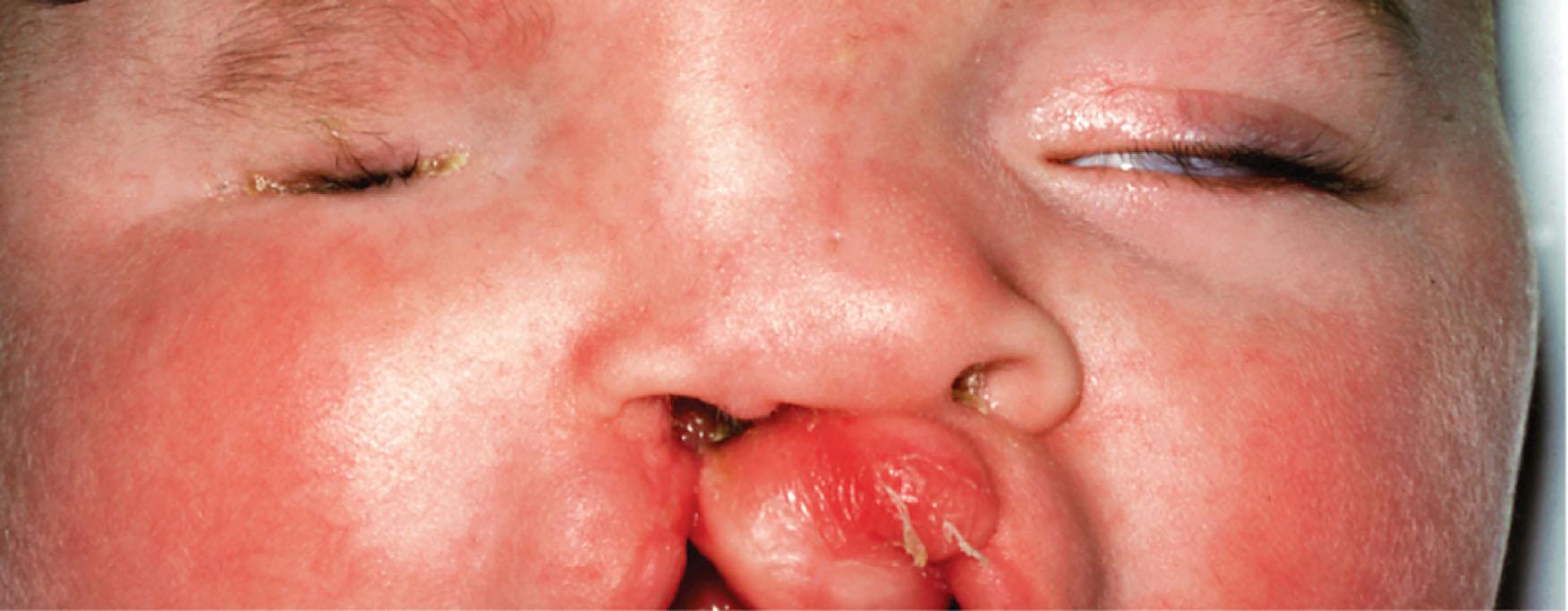
In Delleman syndrome there is an association of skin tags, punched-out lesions of the skin on the ears and elsewhere, mental retardation, hydrocephalus, brain malformations, and orbital cysts.
Microphthalmia also occurs in patients with GOMBO syndrome (growth retardation, microcephaly, brachycephaly, and oligophrenia).
The eyes can be small in some patients with the oculo-dento-digital (ODD) syndrome , which is characterized by bilateral digital anomalies ( Fig. 16.7 ) with cutaneous syndactyly of fingers and camptodactyly, thin nose with hypoplastic alae nasi and small nares, partial dental agenesis, enamel hypoplasia, and glaucoma. Patients with the less common recessive variety of ODD are more likely to have microphthalmia. The syndrome results from mutations in Connexin-43 ( GJA1 ). Iris cysts and anomalous retinal development may occur.
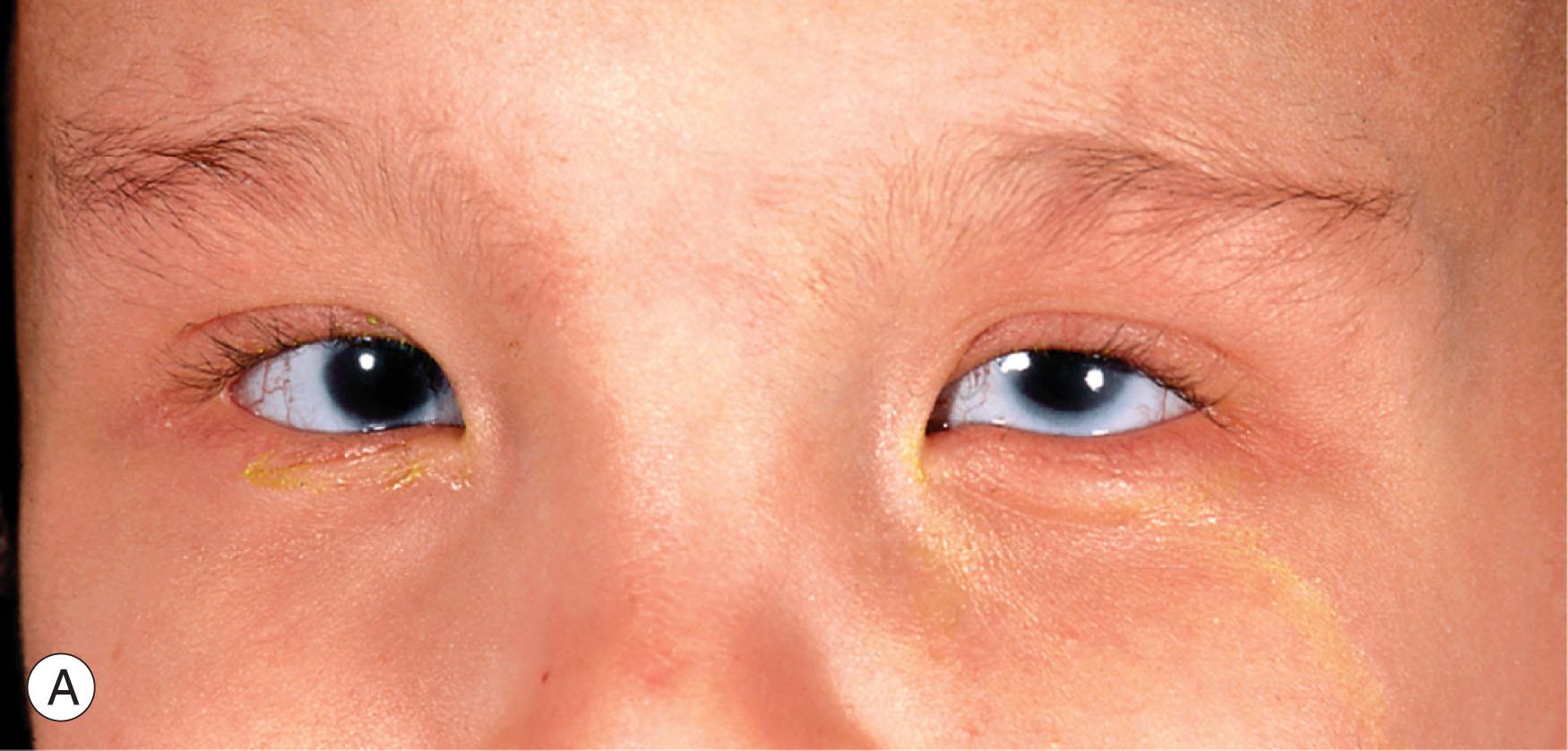
Waardenburg recessive anophthalmia syndrome includes microphthalmia with syndactyly, oligodactyly, and other limb defects, and mental retardation. It is caused by mutations in Sparc-Related Modular Calcium-Binding 1 ( SMOC1 ) and possibly Formin-Binding Protein 4 ( FNBP4 ).
Patients with the X-linked recessive Lenz microphthalmia syndrome have colobomatous microphthalmia with mental retardation, malformed ears, and skeletal anomalies. BCL6 Corepressor ( BCOR ), which maps to Xq27-q28, has been identified as a responsible gene, and the specific missense mutation c.254 C>T has been implicated. Mutations in N-Alpha-Acetyltransferase 10 ( NAA10 ), which maps to Xq28, have also been identified. Oculofaciocardiodental syndrome , presenting with microphthalmia as well as a spectrum of other anomalies, is also associated with BCOR mutations.
The autosomal recessive Warburg MICRO syndrome comprises microphakia, microphthalmia, characteristic lens opacity, atonic pupils, cortical visual impairment, microcephaly, developmental delay by 6 months of age, and microgenitalia in males. It is caused by Rab18 protein deficiency and may result from mutations in RAB3 GTPase-Activating Protein, Catalytic Subunit ( RAB3GAP1 ), RAB3 GTPase-Activating Protein, Noncatalytic Subunit ( RAB3GAP2 ), Ras-Associated Protein Rab18 ( RAB18 ), and TBC1 Domain Family, Member 20 ( TBC1D20 ).
Microphthalmia has been uncommonly described in Rubinstein-Taybi syndrome , in which patients can have mental retardation, delayed growth, as well as characteristic craniofacial abnormalities, and is associated with mutations in CREB-Binding Protein ( CREBBP ). Other ocular abnormalities may be present as well, including corneal abnormalities, glaucoma, and optic nerve coloboma/dysplasia.
For a complete search of inherited conditions associated with microphthalmia and anophthalmia, consult Online Mendelian Inheritance in Man (OMIM) at http://omim.org/ .
Patients with this form of microphthalmia present with a congenital bulge behind the lower lid ( Fig. 16.8A ). There is a failure of optic fissure closure and the protrusion of a cyst from the posterior coloboma. It can be confused with a congenital cystic eye, but in the latter, the eye is replaced by a cystic structure without lens or other defined eye structures. In microphthalmia with cyst, the small eye is sometimes difficult to visualize and a neoplasm may be suspected. The cyst usually communicates with the eye. Ultrasonography and computed tomography (CT) or magnetic resonance imaging (MRI) aid in diagnosis ( Fig. 16.8B ). Most cases of microphthalmia with cyst are sporadic; familial cases have been reported, with presumed autosomal recessive inheritance.
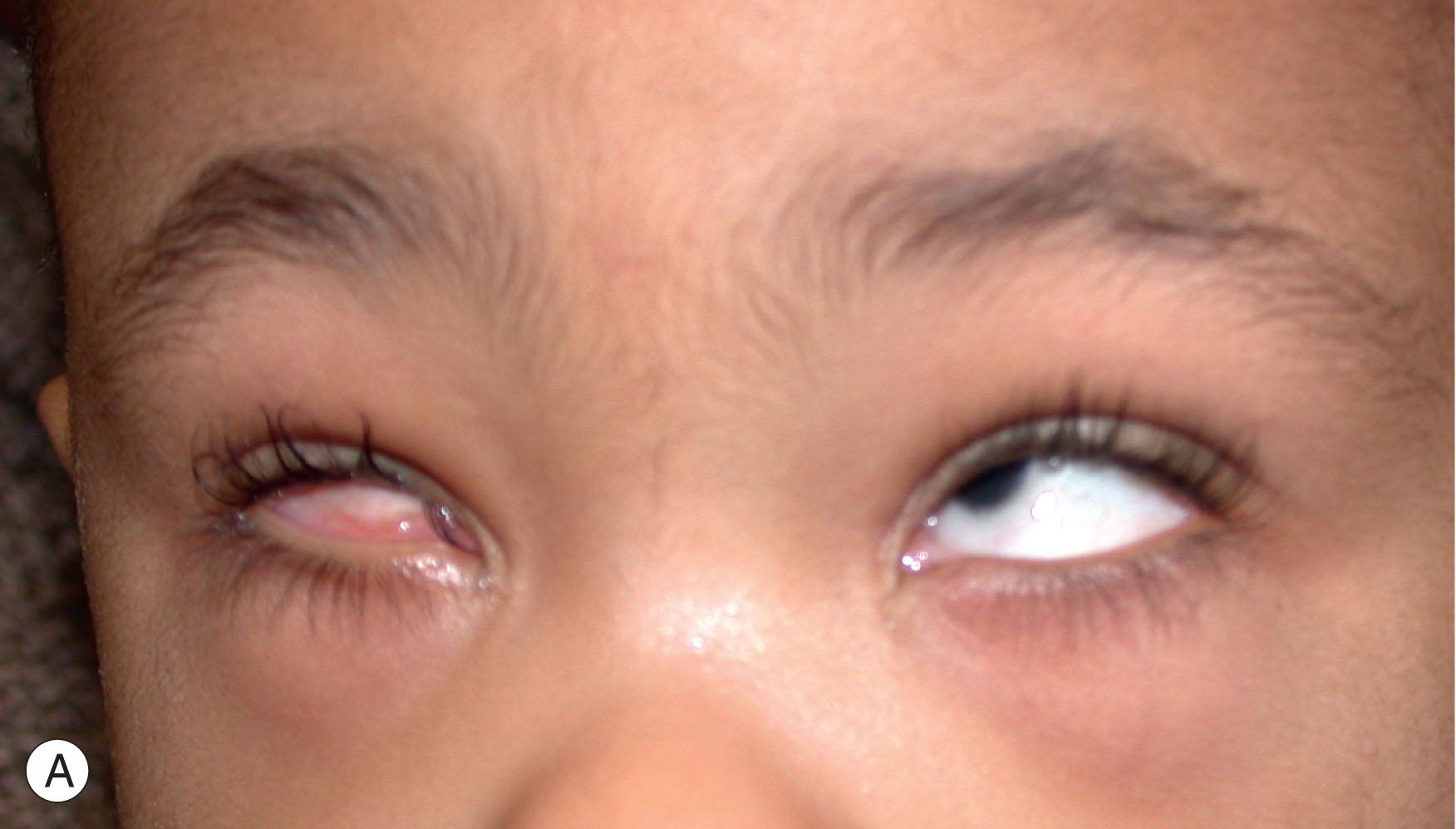
Management is initially conservative, especially for small cysts. Large cysts may be managed with repeated aspiration or by surgical removal. If the cyst is not growing rapidly, it may be left in place until some orbital growth is achieved. Because the cyst communicates with the eye, its removal may deflate the microphthalmic eye, necessitating the removal of the latter.
Become a Clinical Tree membership for Full access and enjoy Unlimited articles
If you are a member. Log in here